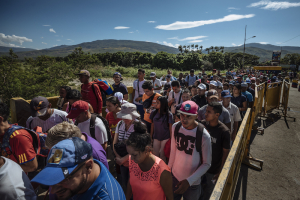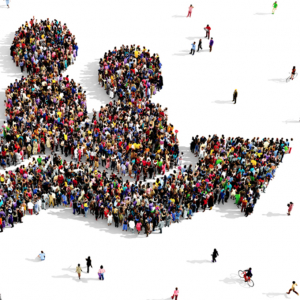Indicators in this domain assess the extent to which migrants have the same status as citizens in terms of access to basic social services such as health, education, and social security. It also describes the rights of migrants to family reunification, to work, and to residency and citizenship. The ratification of the main international conventions is also included within this domain.
Indicators in this category look at the extent to which migrants have access to certain social services such as health, education and social security. They also examine measures to ensure integration and access to work.
Indicators in this domain assess countries’ institutional, legal, and regulatory frameworks related to migration policies. Domain 2 also reviews the existence of national migration strategies that are in-line with development, as well as institutional transparency and coherence in relation to migration management. This domain also investigates the extent to which governments collect and use migration data.
Indicators in this category assess the institutional frameworks of cities for migration. This area also examines the existence of migration strategies consistent with development objectives, as well as institutional transparency and coherence in migration management.
This domain focuses on countries’ efforts to cooperate on migration-related issues with other states and with relevant non-governmental actors, including civil society organizations and the private sector. Cooperation can lead to improvements in governance by aligning and raising standards, increasing dialogue and providing structures to overcome challenges.
Indicators in this category focus on cities’ efforts to cooperate on migration issues with the national government as well as other cities and relevant non-governmental actors, including civil society organizations and the private sector.
This domain includes indicators on countries’ policies for managing the socioeconomic well-being of migrants, through aspects such as the recognition of migrants’ educational and professional qualifications, provisions regulating student migration and the existence of bilateral labour agreements between countries. Indicators equally focus on policies and strategies related to diaspora engagement and migrant remittances.
Indicators in this category assess cities’ initiatives in terms of international student mobility, access to the labour market and decent working conditions for migrant workers. Aspects related to diaspora engagement and migrant remittances are also included in this domain.
This domain studies the type and level of preparedness of countries when they are faced with mobility dimensions of crises, linked to either disasters, the environment and/or conflict. The questions are used to identify the processes in place for nationals and non-nationals both during and after disasters, including whether humanitarian assistance is equally available to migrants as it is to citizens.
Indicators in this category examine the type and level of readiness of cities to deal with aspects of mobility crises. The questions focus on the processes in place for citizens and non-citizens both during and after disasters, especially if humanitarian assistance is available for migrants and citizens.
This domain analyses countries’ approach to migration management in terms of border control and enforcement policies, admission criteria for migrants, preparedness and resilience in the case of significant and unexpected migration flows, as well as the fight against trafficking in human beings and smuggling of migrants. It also assesses efforts and incentives to help integrate returning citizens.
Indicators in this category look at the cities’ approaches to migrant safety as well as return and reintegration policies and the fight against trafficking in persons.
This country Profile describes examples of well-developed areas of Republic of Azerbaijan’s governance structures and areas with potential for further development, as evaluated through the six domains of the Migration Governance Indicators (MGI). These address migrants’ rights, a “whole-of-government” approach, partnerships, socioeconomic well-being of migrants, the mobility dimensions of crises, and safe and orderly migration.
Click the icons on the wheel to explore the key findings.
The Migration Governance Indicators (MGI) initiative is a policy-benchmarking programme led by the International Organization for Migration (IOM) and implemented with research and analysis from the Economist Impact. Funding is provided by IOM Member States.
Migration Governance: examples of well-developed areas
- All migrants in Azerbaijan, regardless of migration status, have access to government-funded health services on par with nationals.
- Regular migrants have access to social protection, including employment insurance, old-age pension, and maternity leave depending on their residency status.
- Azerbaijan has bilateral agreements with several countries on the portability of old- age pensions and social security benefits and entitlements.
- The Migration Code (2013) includes a family reunification procedure for family members of migrants and students in possession of temporary residence.
Areas with potential for further development
- Foreigners and stateless persons with temporary residence permits in the territory of Azerbaijan, refugees and asylum-seekers pay different fees compared with citizens, and higher education.
- Limited civil registration services are extended to migrants without legal proof of identity in Azerbaijan.
Migration Governance: examples of well-developed areas
- Azerbaijan's Migration Code (2013) consolidates immigration laws, covering visas, residence permits, citizenship, and emigration regulations.
- The State Migration Service (SMS) established in 2007 develops and implements migration policy in Azerbaijan.
- The State Committee on Work with Diaspora established in 2008 is responsible for the implementation of State policy in the field of work with the diaspora, Azerbaijanis living abroad, the diaspora organizations established by them, as well as the diasporas of other nations that have a friendly attitude towards Azerbaijan.
- The SMS publishes monthly migration data through the Unified Migration Information System (UMIS). In addition, the State Statistical Committee publishes data on international migration on an annual basis.
Areas with potential for further development
- There is no national inter-ministerial coordination mechanism for migration.
- Similarly, there are no formal arrangements to enhance vertical coherence of migration-related policies in Azerbaijan.
Migration Governance: examples of well-developed areas
- Azerbaijan participates in several regional consultative processes, including the Almaty Process (2013), the Budapest Process (1991) and the Prague Process (2009).
- The Government formally engages civil society organizations (CSOs) in agenda-setting and the implementation of migration-related policies through the Public Council under the State Migration Service (SMS).
- The Government formally engages the private sector in agenda-setting and the implementation of migration-related policies through the Advisory Board under the SMS on a regular basis.
- Azerbaijan signed migration cooperation agreements with Belarus (2019), Kazakhstan (2019), and Turkmenistan (2020).
Areas with potential for further development
- Azerbaijan lacks a formal government framework for diaspora engagement in migration policy; however, the State Committee coordinates with the diaspora on an ad hoc basis.
Migration Governance: examples of well-developed areas
- The Migration Code of Azerbaijan (2013) outlines procedures for determining the annual intake of foreign labor based on demand and supply in the labor market.
- Azerbaijan conducts a labour market analysis on an annual basis to determine labour quotas for the year.
- The government formalizes foreign qualification recognition criteria through participation in Lisbon Convention (1997) and Bologna Process (2005).
- Azerbaijan has measures in place to promote ethical recruitment of migrant workers under the Ministry of Labour and Social Protection of the Population.
Areas with potential for further development
- The Labour Code (1999) and the Law on Employment (2018) contain provisions on gender equality in general, but they do not address gender equality among migrants.
- The country is not actively involved in promoting the creation of formal remittance schemes.
Migration Governance: examples of well-developed areas
- The Law on State Policy Connected with Azerbaijanis Living Abroad (2002) includes provisions to extend humanitarian and consular assistance for Azerbaijanis abroad.
- Azerbaijani’s Presidential Decree No. 1182 of 2005 establishes the Ministry of Emergency Situations (MES) as the central executive body for protecting the population from natural and man-made disasters and implementing civil defence policy.
- The Government informs the public about emergencies and civil defence activities covering the entire population of Azerbaijan in accordance with the Law on Civil Defence (1997).
- The Ministry of Emergency Situations (MES) operates an early warning system to communicate with the public regarding disasters and crises.
- The Azerbaijan 2030: National Priorities for Socio-Economic Development (2021) prioritizes internally displaced people (IDPs), making them a central focus of the strategy.
Areas with potential for further development
- Developing an emergency management framework and implementing specific measures to aid migrants during crises is identified as an area for further development.
- Azerbaijan lacks a contingency plan for managing large-scale population movements during crises.
Migration Governance: examples of well-developed areas
- Established by Decree No. 740 in 2002 by the President of Azerbaijan, the State Border Service operates within a unified system to ensure the protection of Azerbaijan's state border.
- Immigration officers can access training programs offered by the Academy of the State Border Service, established in 2007.
- The National Action Plan for the Fight against Human Trafficking in the Republic of Azerbaijan 2020–2024 (2020), along with the Law on Combating Trafficking in Human Beings (2005) and the Criminal Code (1999), outline strategies to combat trafficking.
- Azerbaijan has multiple bilateral agreements containing clauses that address migrant smuggling.
Areas with potential for further development
- Azerbaijan does not have a formal programme focused on attracting nationals who have migrated from the country.
- There is no policy or strategy to ensure that migrant detention is used only as a measure of last resort.
- There are no specific measures in place to identify vulnerable migrants, but the State Migration Service (SMS) responds to individual cases raised by migrants, representative groups, and NGOs, offering support and referrals.
2023 October




